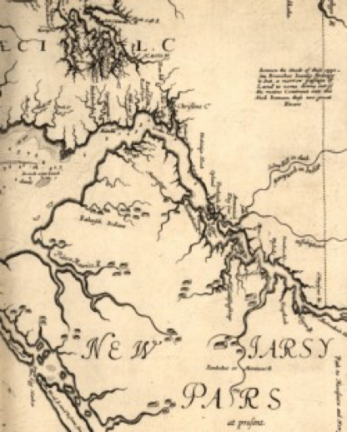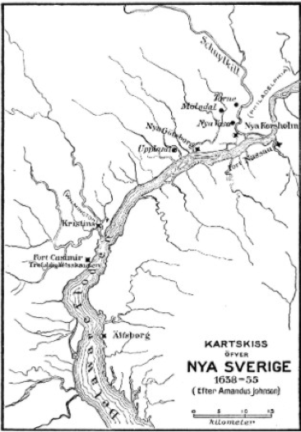
The story below was previously published in the Merion Friends Meeting April 2021 Newsletter. The article was written by Janet Frazer.
Lower Merion Township’s official history begins in 1682 after Penn established his colony and sold the land to the Welsh Quakers who founded Merion Friends Meeting. But the area was not empty when these travelers arrived! Quaker Thomas Evan’s son reported that when his father arrived in Merion that year he was thirsty and given a drink of water by an elderly Swede and his wife. Dr. Edward Jones later recalled that shortly after his family’s arrival, “the Indians brought venison to our door for six pence ye quarter .” Thomas Paschal, an immigrant from Bristol, England, who lived at Kingsessing (Southwest Philadelphia) wrote in 1683 that “Swedes provide food and housing for the newcomers but also essential services in negotiating with the native Indians”. So the Delaware Valley was not an unoccupied wilderness when the Quakers arrived.

Of course, the Lenape were the oldest inhabitants of Lenapehoking, and by 1600 controlled eastern Pennsylvania (as well as parts of New Jersey and Delaware), with several unpalisaded towns along the Delaware River and at least two more along the Schuykill*. Lenape artifacts have been found at Riverbend Environmental Center in Gladwyne, as well as nearby areas such as Manayunk, Broomall and Philadelphia. By 1654, a Swedish engineer, Peter Lindestrom, claimed that most of the 4000 Lenape at that time lived on the West Bank of the Delaware River near the Schuykill. They hunted, fished, gathered and planted crops (often selling maize to Europeans who lacked adequate foods when they first came) but after the Europeans arrived, they increased their trading activities, mainly exchanging beaver furs for European items they lacked, like metal tools, cloth or food during their own “starving times”. In return for annual gifts, the Lenape granted the use of their land for trade.
*Early studies described the Lenape as bands of foragers, but by 2015 historians had identified Lenape villages of agriculturalists who continued to hunt, fish and gather, but increased their planting, even raising corn for sale to the Europeans.

The Dutch were the first Europeans to arrive in Lower Merion, sailing down the Delaware River in 1623 and building a trading post opposite the mouth of the Schuykill River.
These male traders initially came to trade and were welcomed by the Lenape, but in 1631 tried to establish a plantation on land purchased from the Lenape at Swanendael, Delaware. The Lenape killed all 32 residents because they had agreed to the sale (really the use) of the site for trade only, not for agriculture. After that lesson, the Dutch went back to the fur trade, building only trading forts.

In 1638 the Swedes arrived in the Delaware Valley. Unlike the Dutch, they came prepared to found a colony and their settlements spread along the Delaware and Schuykill Rivers. Swedes got along well with the Lenape because they provided goods in demand such as copper kettles and they accepted the Lenape view of a land sale as temporary use renewed with continuous gifts. The Swedes claimed that their relationship with the Lenape were “like brothers and sisters”. Well before Penn’s arrival in 1682, Swedish and Finnish settlers founded churches, schools and courts. They might have done business at a Narberth trading post, although no evidence of this has been found. Narberth’s oldest building, a log cabin at 610 Shady Lane, is reportedly Swedish. The town’s oldest piece of construction is a chimney of the original log cabin, probably Swedish, that once stood at 1226 Montgomery Avenue. After the English arrived, the Swedes and Finns served as interpreters in the purchase of lands from the Lenape. The census of 1697 recorded 1200 Swedes living in Pennsylvania.

In 1664, the Lenape still outnumbered Europeans and dominated relations in the Delaware Valley.* They held onto their land by insisting on payment and refusing surveys.
When Penn arrived in 1682, the number of English immigrants began to skyrocket, overwhelming the Lenape. Initially, the Indians negotiated successfully with Penn and most settlers accepted their treaty protocols and the joint use of property. At the same time, dams built by the new settlers blocked the fish, their farms reduced hunting in the woodlands and smallpox* reduced Lenape numbers. By 1697, the Lenape were scarce in the Philadelphia area but continued to live in autonomous towns in Bucks County and along the upper Schuykill and Brandywine Rivers.
Smallpox was not a new disease for the Lenape; along with measles and influenza, it arrived before the Dutch landed and reduced the population from 7600 in 1600 to 3000 in 1672.
Within another 40 years, most Lenape of southeastern Pennsylvania had moved westward. The Dutch were mostly gone by then as well, but Swedes and Finns could still be found among the English colonists.
The Lenape dominated the Delaware Valley for many years, adapting to a beneficial trade as small numbers of Europeans arrived but controlling the outsiders’ land usage. They maintained their traditions while selectively acquiring foreign technology. By 1682, Southeast Pennsylvania was a diverse and generally peaceful territory of Lenape, Dutch and Swedish villages that negotiated with (and sometimes married) each other. It could be said that Penn did not found the colony but only changed its name.
Merion Meeting Event April 18
Merion meeting is hosting a meeting history talk Sunday April 18th from 2:00-4:00. Register at www.merionfriends.org and a Zoom link will be forwarded to you prior to event. Know Thy Neighbor is a continuing series of conversations intended to share our history as well as our current civic engagement with the community.
Featured speaker DANIEL CAMPBELL is a registered architect with thirty years of experience in architecture and historic preservation. Dan will share his extensive knowledge of the meeting house and the horse sheds. Dan has worked with Merion Meeting for the last 15 years on the historical preservation of the Meeting House. This will be an engaging and enlightening opportunity for you to learn more about one of the oldest buildings in the township and its remarkable history.
Main Image: A Lenape family by the Swedish engineer, Peter Lindestrom, 1654
Sources
Barker, Charles. “Glimpses of Lower Merion History”. Lower Merion Historical Society. Accessed February 20, 2021. http://www.lowermerionhistory.org/texts/barker.html
Becker, Marshall. “The Lenape”. The First Three Hundred Years. Ardmore: LMHS, 2000.
Becker, Marshall. LENAPE (“DELAWARE”) IN THE EARLY COLONIAL ECONOMY: CULTURAL INTERACTIONS AND THE SLOW PROCESSES OF CULTURE CHANGE BEFORE 1740. Northeast Anthropology No. 81-82, 2014, pp. 109–129. Accessed 2/8.
Becker, Marshall Joseph. “Lenape Population at the Time of European Contact: Estimating Native Numbers in the Lower Delaware Valley.” Proceedings of the American Philosophical Society 133, no. 2 (1989): 112-22.
Accessed February 13, 2021. http://www.jstor.org/stable/987042.
Becker, Marshall. Mehoxi of the Cohansey Band of Lenopi. Bulletin of the Archaeological Society of Delaware, Vol. 44, 2007.
Becker, Marshall. Search for the Lenape Indians. Becker, Marshall J. “Search for the Lenape Indians.” Archaeology 35, no. 3 (1982): 10-19. Accessed February 13, 2021. http://www.jstor.org/stable/41727825.
Becker, Marshall. Wampum use by Lenape and Swedes in Colonial America: A tale of sex and violence involving ‘decorative’ belts of wampum. Digital Commons @ West Chester University. West Chester: West Chester University, 2005.
Bede, ElizaBeth Anne (1990). The Site Development of “Black Rocks” Located in Lower Merion Township Montgomery County, Pennsylvania. (Masters Thesis). University of Pennsylvania, Philadelphia, PA. Url** Accessed
Mooney, Douglas. “Native American Sites in the City of Philadelphia — Elusive but not Gone”. Philadelphia Archaeological Forum, 2010. Accessed March 5, 2021.
https://www.phillyarchaeology.net/wp-content/uploads/2012/09/more-1.jpg
CRAIG, Peter S. “THE 1693 CENSUS OF THE SWEDES ON THE DELAWARE”. Winter Park SAG Publications,
1993. http://nc-chap.org/cranehook/pdfs/census_1693.pdf Accessed February 26, 2021.
Donahoe,Victoria. “Clues & Findings: Swedish-Indian Trading Post”. Norristown: Montgomery County Historical Society, 1982. https://narberthhistory.org/sources/swedish-indian-trading-post. Accessed February 26, 2021.
Donahoe,Victoria. “Narberth—A History”. Narberth: Friends of Narberth History, 1994. https://narberthhistory.org/stories/narberth-history accessed 2/9/2021.
Glenn, Thomas Allen. Merion in the Welsh Tract. Norristown: Herald Press, 1896. https://archive.org/stream/cu31924010481723#page/n51/mode/2up accessed 2/17/21.
Haefeli, Evan. “The Revolt of the Long Swede: Transatlantic Hopes and Fears on the Delaware, 1669.” The Pennsylvania Magazine of History and Biography 130, no. 2 (2006): 137-80. Accessed February 9, 2021. http://www.jstor.org/stable/20093851.
Immonen, Visa. “Farming and Brass Kettles as Forms of Colonial Encounter: New Sweden from an Archaeological Perspective.” Scandinavian Studies 83, no. 3 (2011): 365-86. Accessed February 20, 2021. http://www.jstor.org/stable/23075473.
“The Indians of Pennsylvania”. Explore Pennsylvania History. https://explorepahistory.com/story.php?storyId=1-9-14&chapter=1. Accessed February 26, 2021.
Johnson, Dr. Amandus. “The Stones Speak (Stenarna Tala)”. Swedish Colonial News. Vol. 3, No. 2, 2005. Url **. Accessed?
Licht, Walter, Mark Frazier Lloyd, J.M. Duffin, & Mary D. McConaghy. The Original People and Their Land: The Lenape, Pre-History to the 18th Century. West Philadelphia Collaborative History. Accessed: February 20, 2021.
https://collaborativehistory.gse.upenn.edu/stories/original-people-and-their-land-lenape-pre-history-18th-c entury.
Mooney, Douglas. “Native American Sites in the City of Philadelphia — Elusive but not Gone”. Philadelphia Archaeological Forum, 2010. Accessed March 5, 2021.
https://www.phillyarchaeology.net/wp-content/uploads/2012/09/more-1.jpg Soderlund, Jean. Lenape Country. Philadelphia: UPenn, 2015.
Soderlund, Jean. “Natives Peoples Before 1682”. Encyclopedia of Greater Philadelphia. accessed 2/25/21. https://philadelphiaencyclopedia.org/archive/native-peoples-to-1680/
Sugrue, Thomas J. “The Peopling and Depeopling of Early Pennsylvania: Indians and Colonists, 1680-1720.” The Pennsylvania Magazine of History and Biography 116, no. 1 (1992): 3-31. Accessed February 13, 2021. http://www.jstor.org/stable/20092669.
Weigley, Russell F. et al. Philadelphia: A 300-Year History. New York: W.W. Norton Co., 1982.